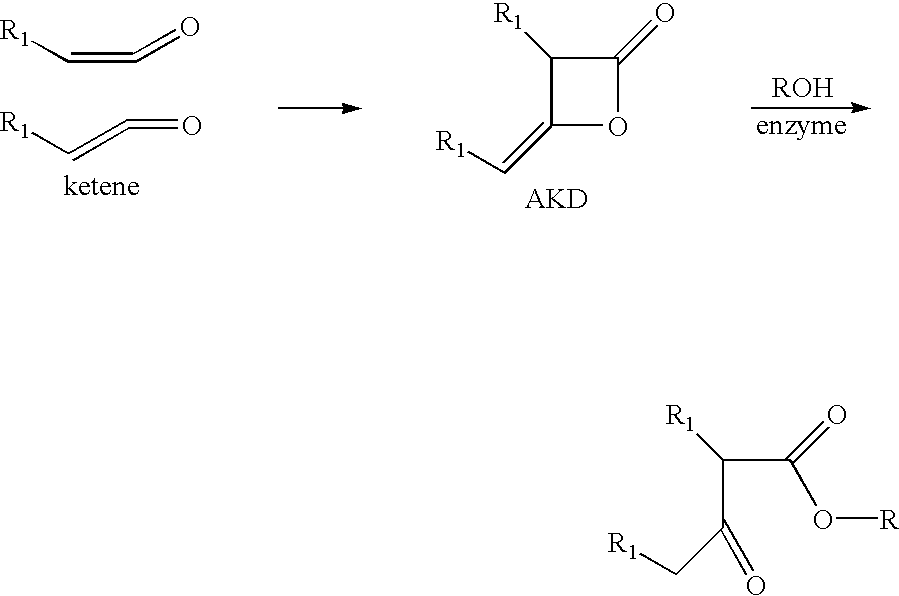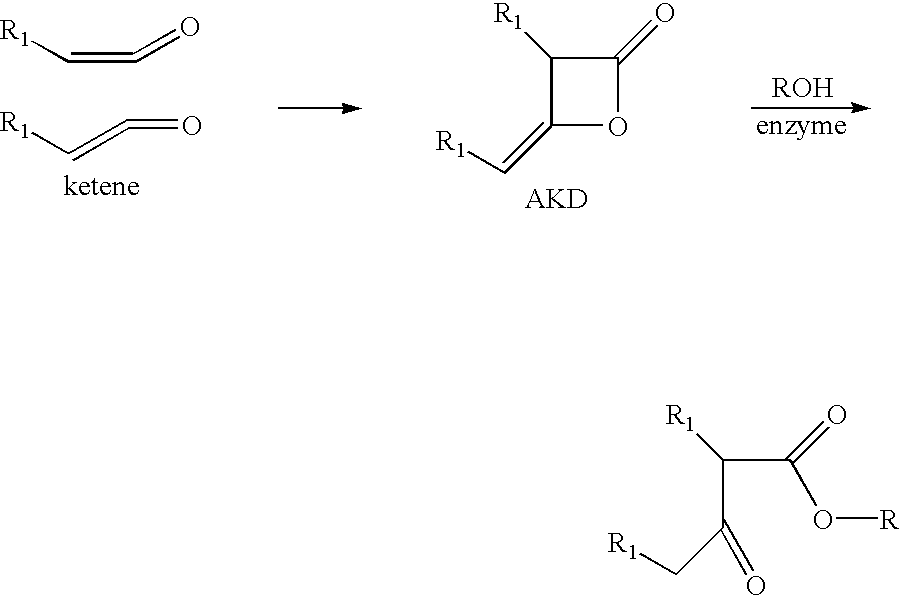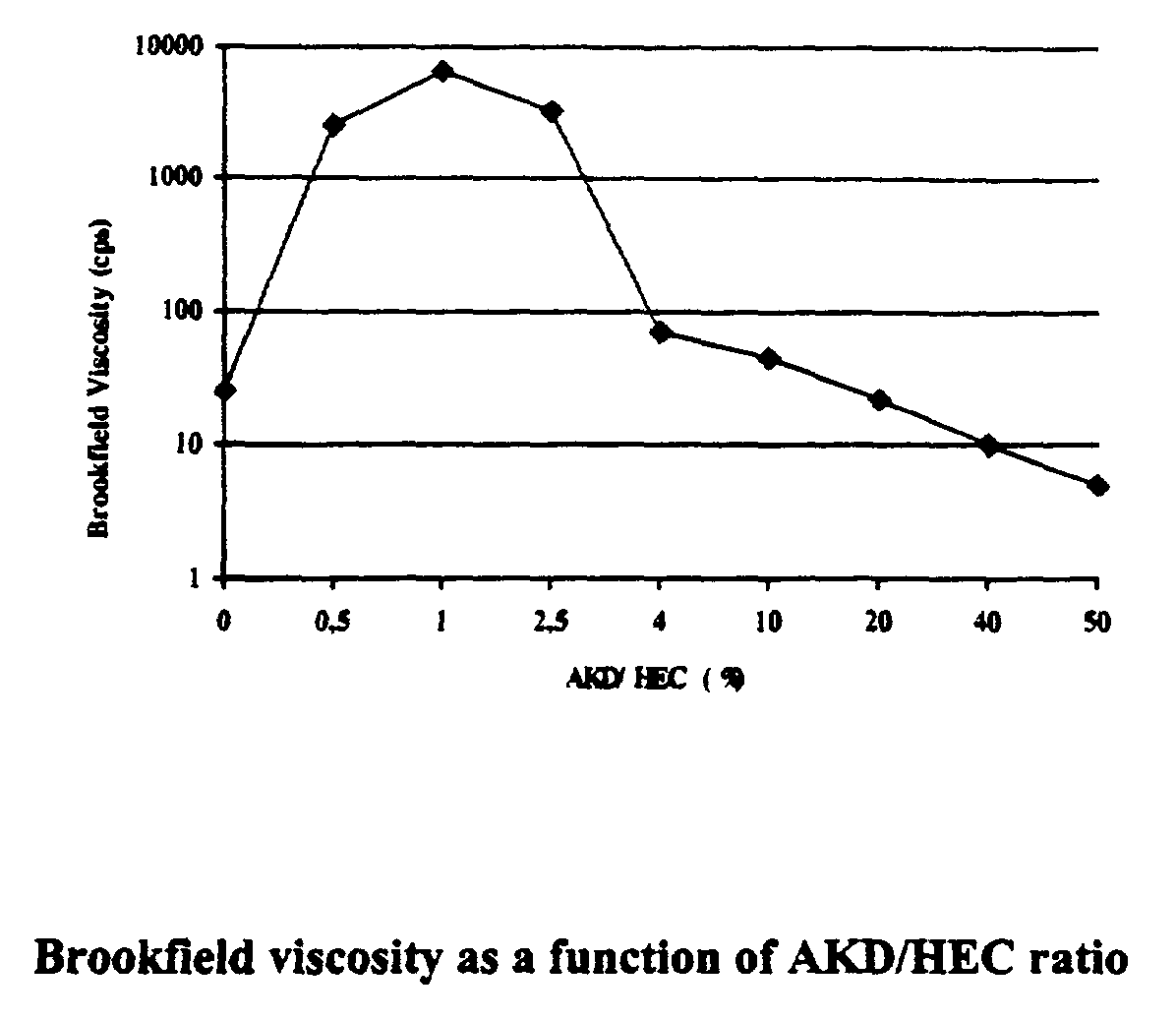Esterified polysaccharide products and beta-lactone ring opened ketene dimer products containing the compositions, and process of making the same
- Summary
- Abstract
- Description
- Claims
- Application Information
AI Technical Summary
Problems solved by technology
Method used
Image
Examples
example 2
[0052] An HEC sample (HEC 250GR, Hercules, 10 g, 0.5 mol) having a molar substitution of 2.5 is suspended in 200 ml of N, N-dimethylformamide (DMF). 2 g of AKD (Aquapel.RTM. 36H, Hercules) are added followed by 1 g of lipase from Pseudomonas sp. (Amano). The reaction mixture is incubated at 50.degree. C. for 48 hours. The mixture is then treated with IPA, and the resulting precipitate is washed with IPA and dried. The product is a water-insoluble material and the yield is about 9.8 g.
example 3
[0053] An HEC sample (HEC 250GR, Hercules, 10 g, 0.5 mol) having a molar substitution of 2.5 is suspended in 200 ml of DMF. 2 g of alkenyl ketene dimer (Precis.RTM., Hercules) are added followed by 1 g of lipase from Pseudomonas sp. (Amano). The reaction mixture is incubated at 50.degree. C. for 24 hours and treated with IPA. The resulting precipitate is washed with IPA and dried. The product is partially soluble in water. The yield is about 10.3 g. IR analysis shows the absorption at 1715 and 1740 cm.sup.-1, corresponding to the ketone and ester functional group, respectively. .sup.13C-NMR shows peaks at 14, 23 and 30 ppm, corresponding to the fatty acid groups, and around 142 ppm which corresponded to the --CH.dbd.CH-- carbons of fatty acid on Precis.RTM.. The IR and NMR results indicate that the addition of AKD onto HEC is achieved.
example 4
[0054] An HEC sample (HEC-250G, Hercules, 10 g, 0.5 mol) having a molar substitution of 2.5 is suspended in 200 ml of DMF, and 0.2 g of alkyl ketene dimer (Aquapel.RTM. 36H, Hercules) is added followed by 0.5 g of lipase from Pseudomonas sp. (Amano). The reaction mixture is incubated at 50.degree. C. for 24 hours and added to IPA. The product that precipitates out is washed with IPA and dried. This product is a water-soluble material and the yield is about 10.0 g. IR absorption at 1715 and 1740 cm.sup.-1 is not detectable. However, the Brookfield viscosity measurement shows about 120 times increase in viscosity as compared to the viscosity of the untreated HEC, indicating the presence of covalent grafting of AKD onto HEC. As a control experiment, simply mixing HEC and AKD using the same ratio (with no enzyme) does not show any viscosity increase.
[0055] The products according to this invention have interesting and useful properties. The Brookfield viscosities of the esterified polysa...
PUM
| Property | Measurement | Unit |
|---|---|---|
| Time | aaaaa | aaaaa |
| Fraction | aaaaa | aaaaa |
| Fraction | aaaaa | aaaaa |
Abstract
Description
Claims
Application Information
 Login to View More
Login to View More - R&D
- Intellectual Property
- Life Sciences
- Materials
- Tech Scout
- Unparalleled Data Quality
- Higher Quality Content
- 60% Fewer Hallucinations
Browse by: Latest US Patents, China's latest patents, Technical Efficacy Thesaurus, Application Domain, Technology Topic, Popular Technical Reports.
© 2025 PatSnap. All rights reserved.Legal|Privacy policy|Modern Slavery Act Transparency Statement|Sitemap|About US| Contact US: help@patsnap.com



